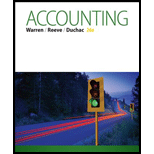
1. a)
Financial Ratios: Financial ratios are the metrics used to evaluate the liquidity, capabilities, profitability, and overall performance of a company.
Given info: Items of financial statement
The Rate earned on total assets for three years.
1. a)
Answer to Problem 17.4CP
Rate earned on total assets for three years:
Explanation of Solution
Rate earned on total assets determines the particular company’s overall earning power. It is determined by dividing sum of net income and interest expense and average total assets.
Formula:
Hence, rate earned on total assets for year 3, year 2, and year 1 are 7.4%, 7.8%, and 6.4% respectively.
b)
The Rate earned on
b)
Answer to Problem 17.4CP
Rate earned on stockholders’ equity for three years
Explanation of Solution
Rate earned on stockholders’ equity is used to determine the relationship between the net income and the average common equity that are invested in the company.
Formula:
Hence,
c)
The earnings per share on the common stock for three years.
c)
Answer to Problem 17.4CP
Earnings per share on the common stock for three years
Explanation of Solution
Earnings per share help to measure the profitability of a company. Earnings per share are the amount of profit that is allocated to each share of outstanding stock.
Formula
Hence, earnings per share for year 3, year 2, and year 1 is $7.72, $6.71, and $4.40.
d)
The dividend yield for three years.
d)
Answer to Problem 17.4CP
Dividend yield for three years
Explanation of Solution
Dividend yield ratio is determined to evaluate the relationship between the annual dividend per share and the market price per share.
Formula
Therefore, dividend yield ratio for Company year 3, year 2, and year 1 are 2.3%, 1.9%, and 1.9% respectively.
e)
The price earnings ratio for three years.
e)
Answer to Problem 17.4CP
Price earnings ratio for three years
Explanation of Solution
Dividend yield ratio is determined as the relationship between market price per share and earnings per share.
Formula
Therefore, price/earnings ratio for Company year 3, year 2, and year 1 are 10.3, 12.0, and 13.9.
2.
Ratio of average liabilities to average stockholders' equity for Year 3.
2.
Answer to Problem 17.4CP
Explanation of Solution
Ratio of average liabilities to average stockholders’ equity is determined by dividing average liabilities and average stockholders’ equity.
Formula:
Average liabilities for three years are determined as the difference between average assets and average stockholder’s equity. They are as below:
3.
To evaluate: D’s profitability.
3.
Explanation of Solution
D’s profitability is measured by earnings per share. It has been improved significantly during the 3-year period. The return on total assets and total stockholders’ equity has improved in a significant manner.
There is a significant improvement in the economy and thus, improved in the construction industry too for the year 2. The capital equipment has improved and thus, dividend yield has increased in the year 3. This increase is due to large increase in the cash dividend.
The price-earnings ratio has deteriorated during three-year period. The share price is increased in the slower rate when compared to earnings.
Want to see more full solutions like this?
Chapter 17 Solutions
Bundle: Accounting, Loose-Leaf Version, 26th + LMS Integrated for CengageNOW, 2 terms Printed Access Card
- please post this question in Account tutors feedarrow_forwardAnticipated unit sales are January, 5,000, February, 4,000, and March 8,000 Finished goods are consistently maintained at 80% of the following month's sales If units cost $10 each to produce, how much is February's total cost of production?arrow_forwardWhat is its net opreting profit after tax?arrow_forward
- Beethoven Corp. had net sales of 45,600 and ending accounts receivable of 5,700 for the current period. Its days' sales uncollected equals: (Use 365 days a year.) a. 40.25 days b. 36.17 days c. 45.63 days d. 32.43 days e. 30.47 daysarrow_forwardAQUA SYSTEMS REPORTS THE FOLLOWING SALES OF $150,000; INFORMATION: BEGINNING ASSETS OF $300,000, ENDING ASSETS OF OF $360,000; NET INCOME $9,000. OF THE RETURN ON ASSETS (TO THE NEAREST WHOLE NUMBER) IS: A. 555% B. 30% c. 3% D. 6%arrow_forwardDetermine the cash payments made during marcharrow_forward
- Provide answerarrow_forwardWhich of the following is NOT considered a fixed asset? A. Machinery B. Accounts Receivable C. Building D. Landarrow_forwardStark Corp is in the process of acquiring another business. In light of the acquisition, shareholders are currently re-evaluating the appropriateness of the firm's capital structure (the types of and relative levels of debt and equity). The two proposals being contemplated are detailed below: Proposal 1 Proposal 2 Estimated earnings before interest and taxes (EBIT) $ 450,000 $ 450,000 Long term debt 1,000,000 2,000,000 Market value of equity 1,000,000 500,000 Interest rate on long term debt 10% 10% Tax rate 25% 25% Required Calculate the estimated return on equity (ROE) under the two proposals. (ROE = net income after taxes / market value of equity; net income after taxes = (EBIT - interest on long-term debt) × (1 - tax rate)).arrow_forward
 Managerial AccountingAccountingISBN:9781337912020Author:Carl Warren, Ph.d. Cma William B. TaylerPublisher:South-Western College Pub
Managerial AccountingAccountingISBN:9781337912020Author:Carl Warren, Ph.d. Cma William B. TaylerPublisher:South-Western College Pub Managerial Accounting: The Cornerstone of Busines...AccountingISBN:9781337115773Author:Maryanne M. Mowen, Don R. Hansen, Dan L. HeitgerPublisher:Cengage Learning
Managerial Accounting: The Cornerstone of Busines...AccountingISBN:9781337115773Author:Maryanne M. Mowen, Don R. Hansen, Dan L. HeitgerPublisher:Cengage Learning Financial AccountingAccountingISBN:9781337272124Author:Carl Warren, James M. Reeve, Jonathan DuchacPublisher:Cengage Learning
Financial AccountingAccountingISBN:9781337272124Author:Carl Warren, James M. Reeve, Jonathan DuchacPublisher:Cengage Learning Financial And Managerial AccountingAccountingISBN:9781337902663Author:WARREN, Carl S.Publisher:Cengage Learning,
Financial And Managerial AccountingAccountingISBN:9781337902663Author:WARREN, Carl S.Publisher:Cengage Learning, Financial AccountingAccountingISBN:9781305088436Author:Carl Warren, Jim Reeve, Jonathan DuchacPublisher:Cengage Learning
Financial AccountingAccountingISBN:9781305088436Author:Carl Warren, Jim Reeve, Jonathan DuchacPublisher:Cengage Learning





